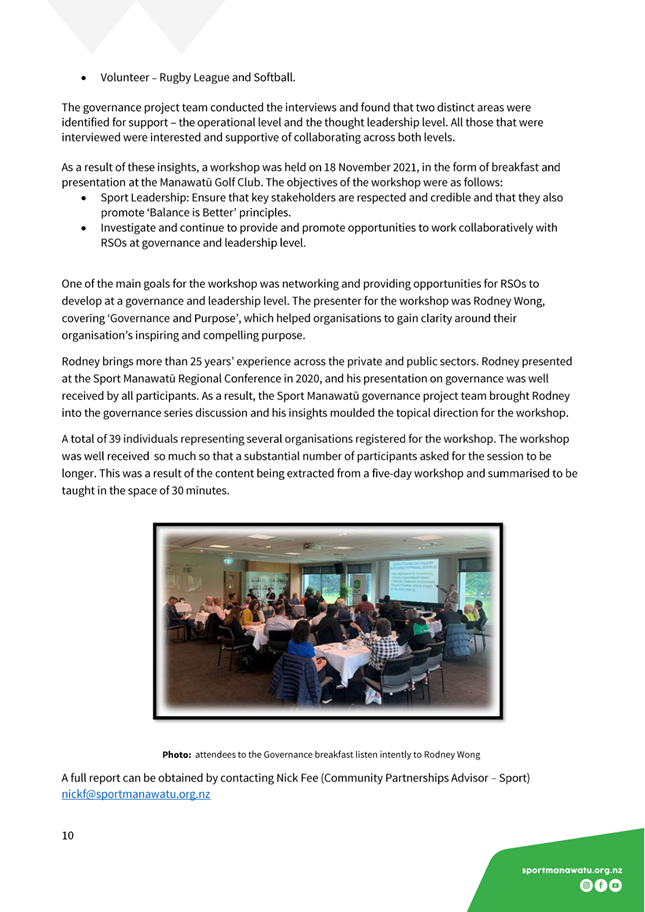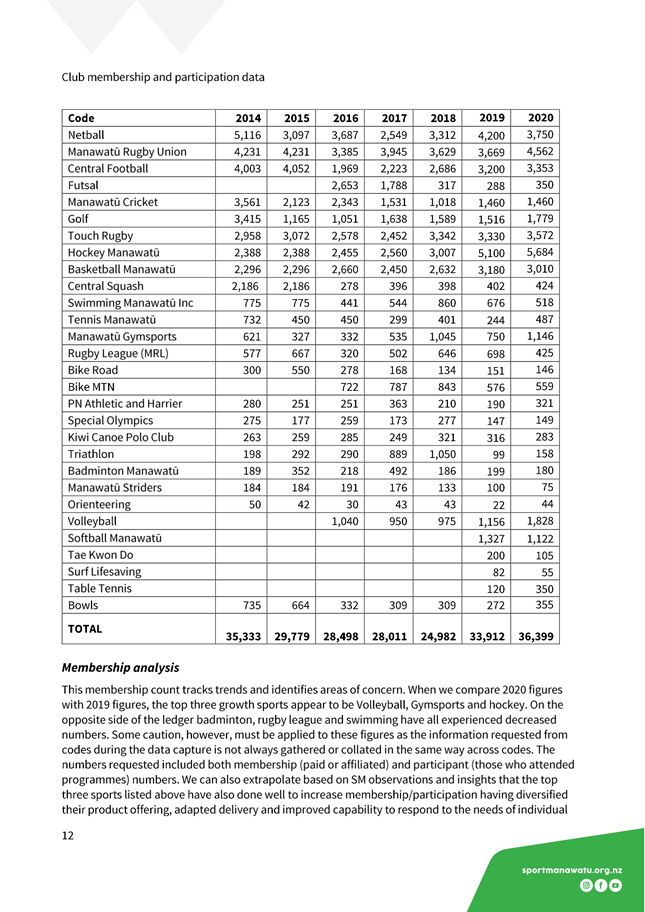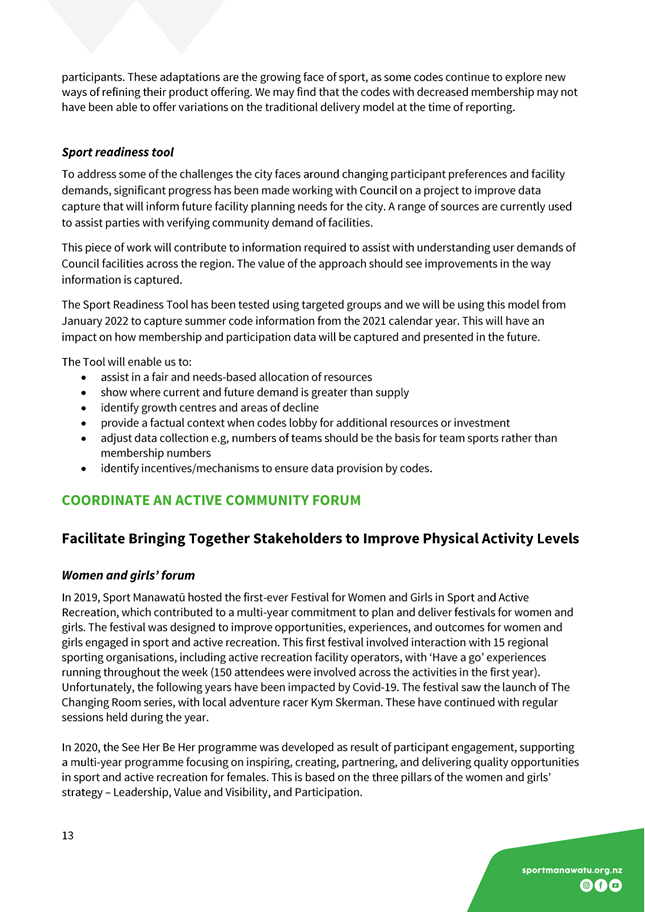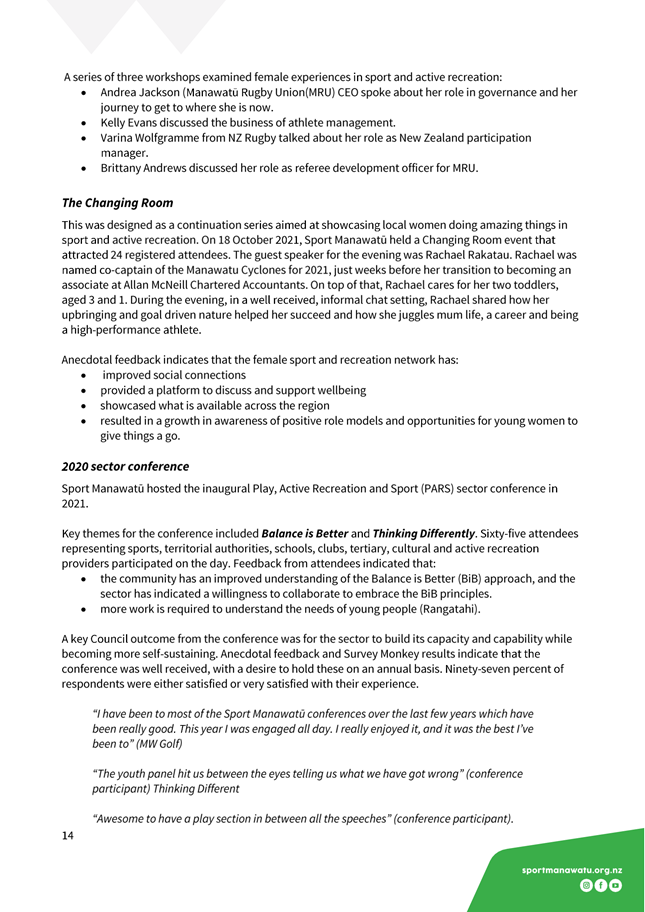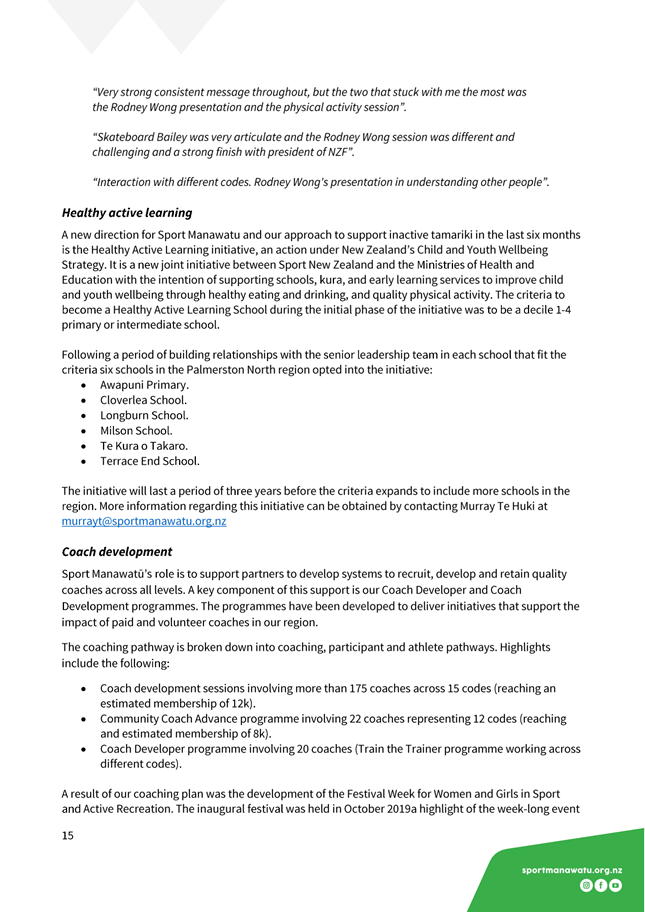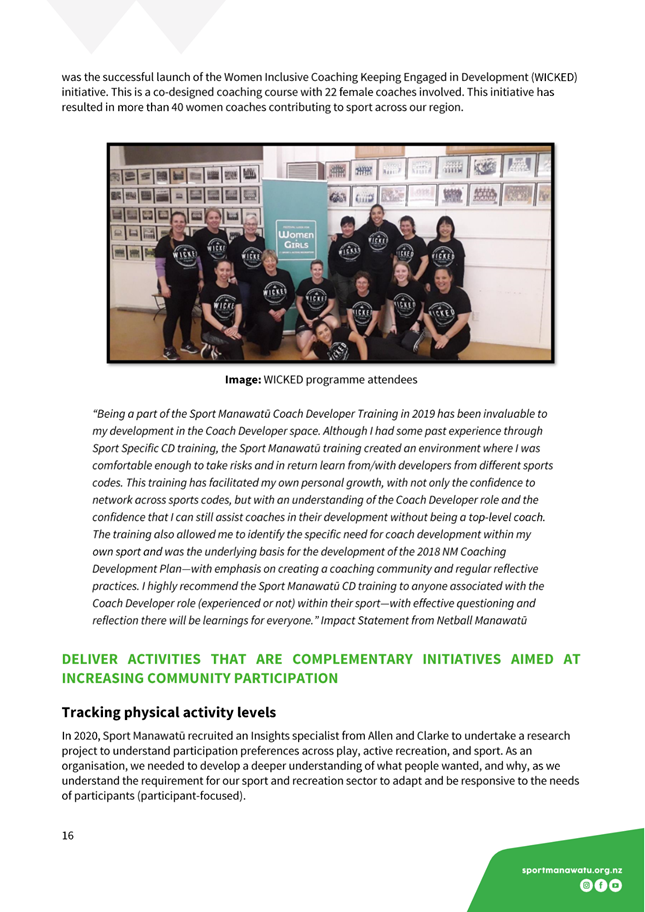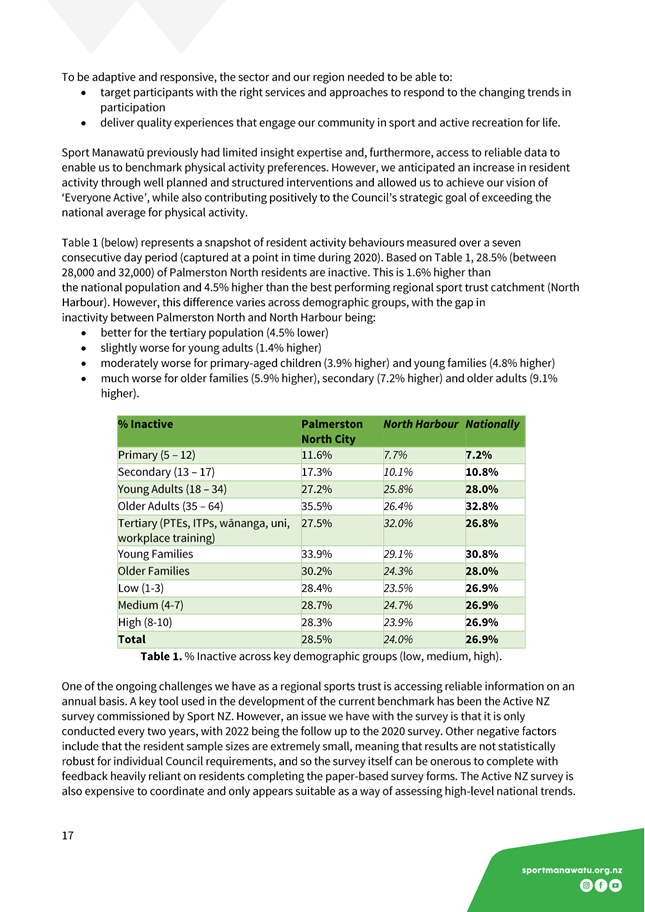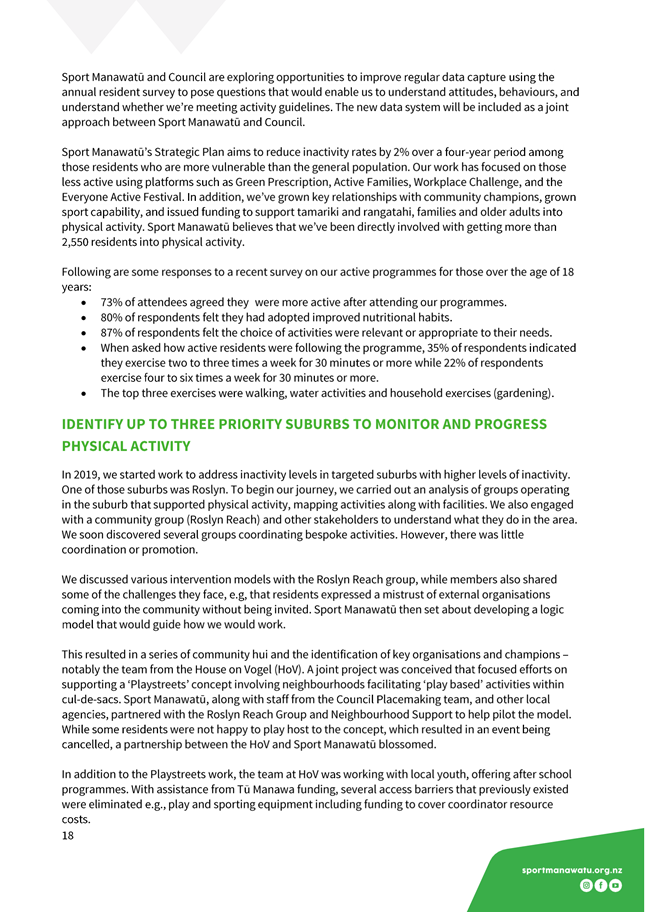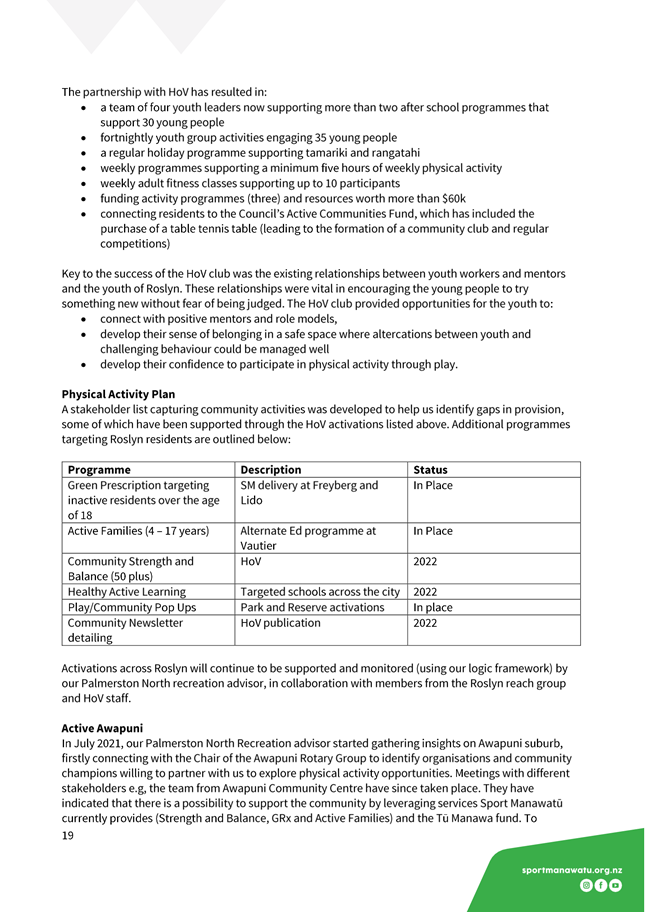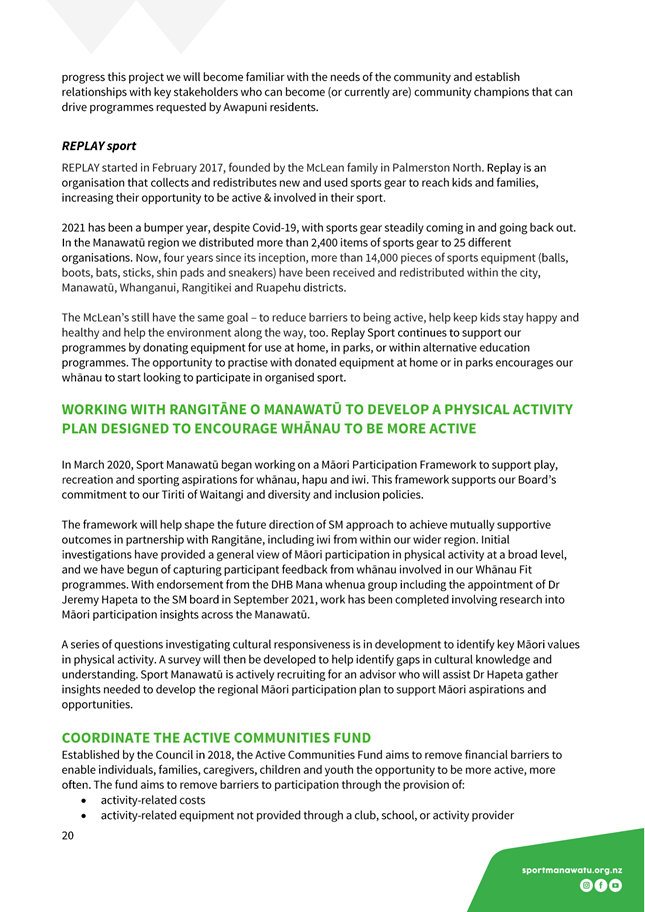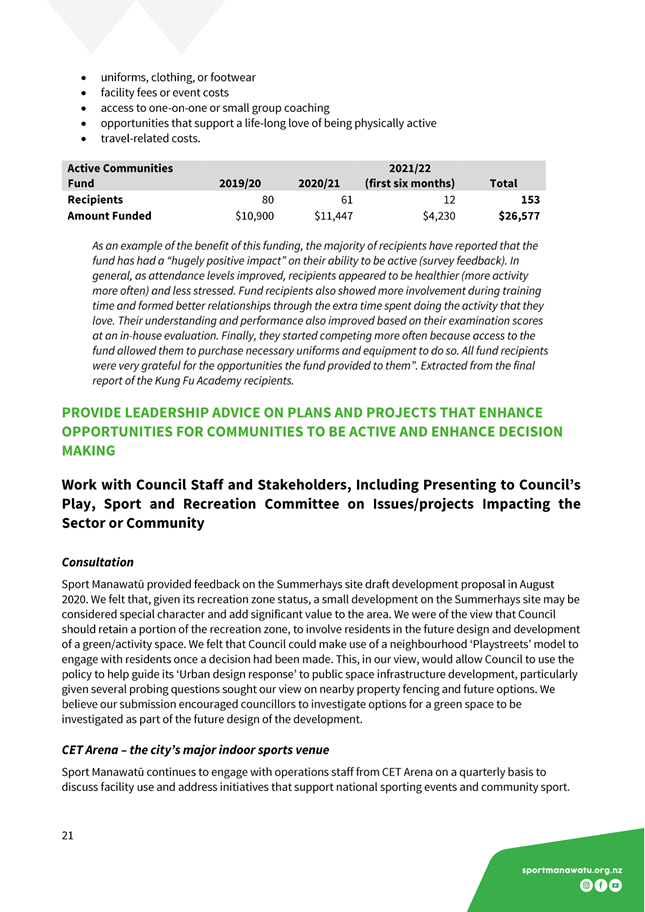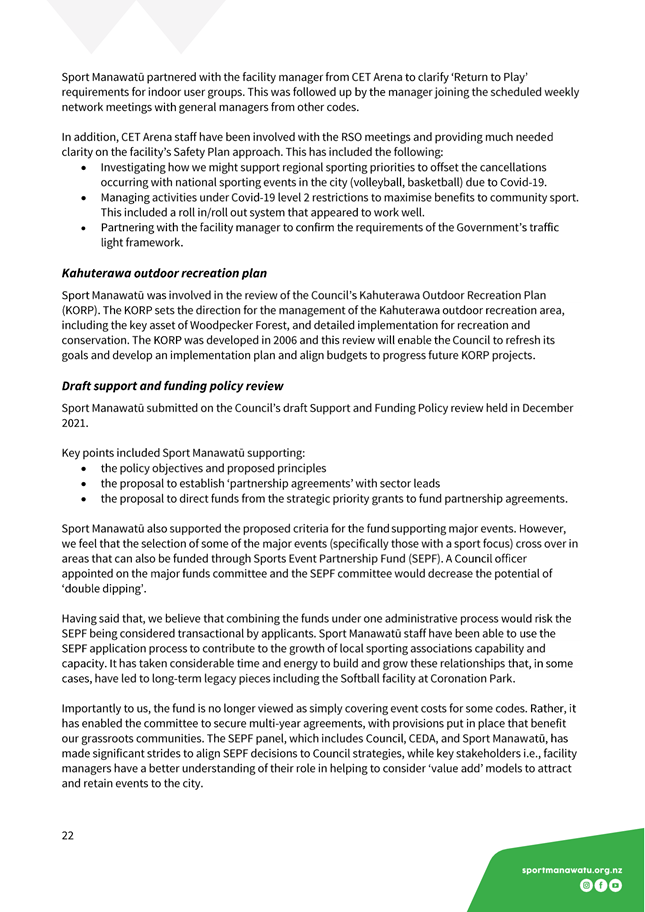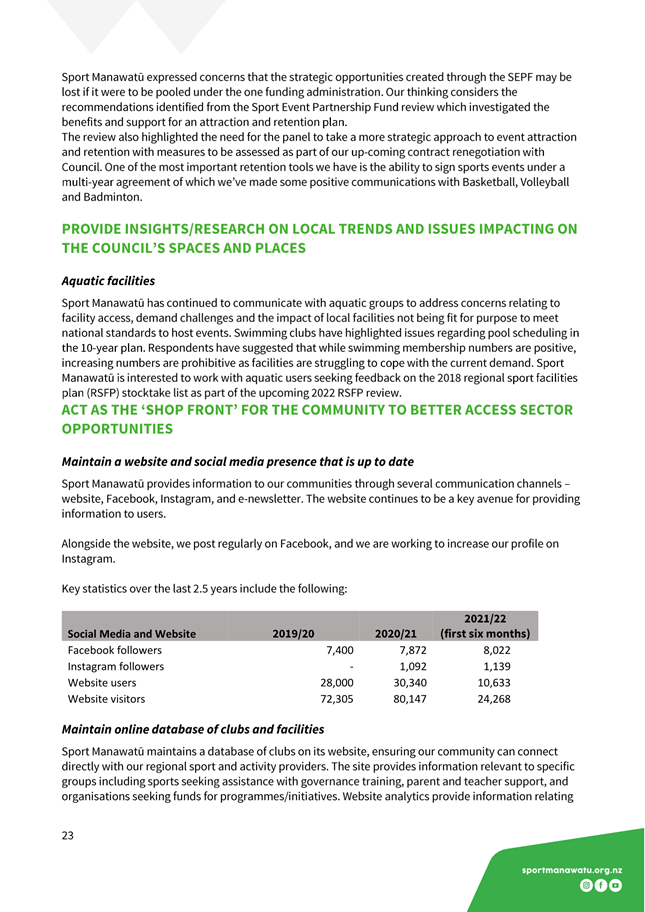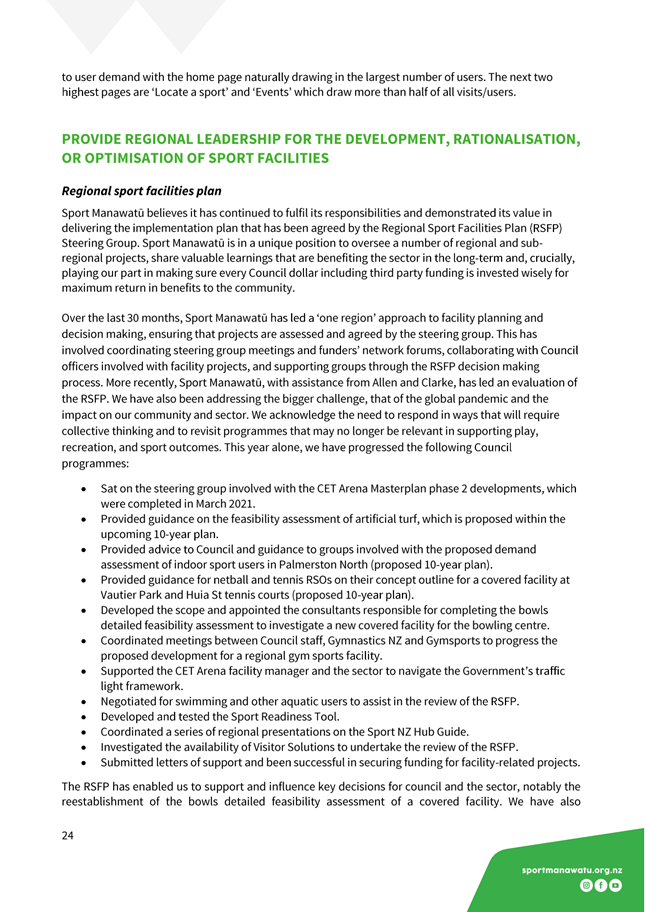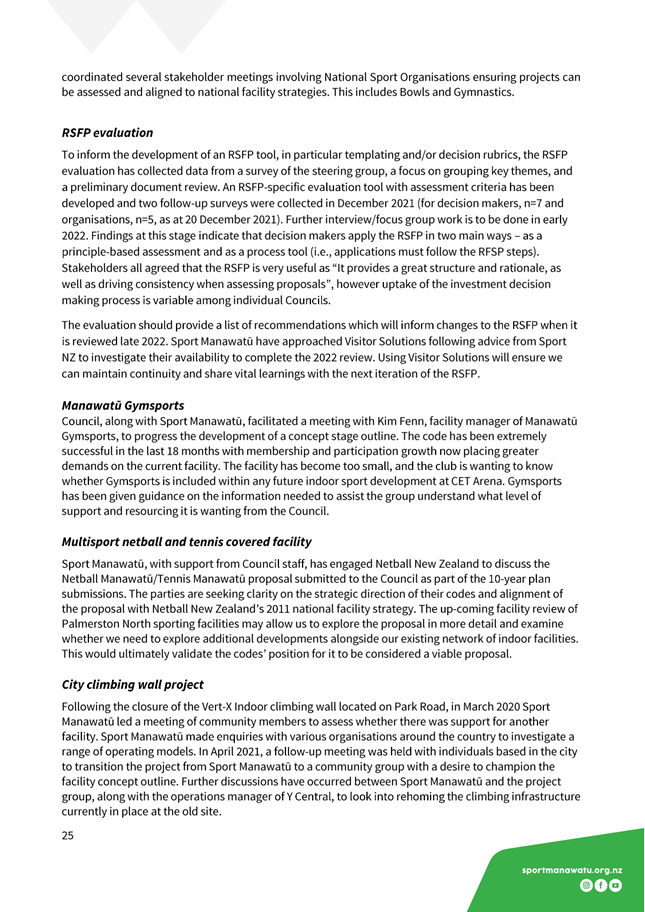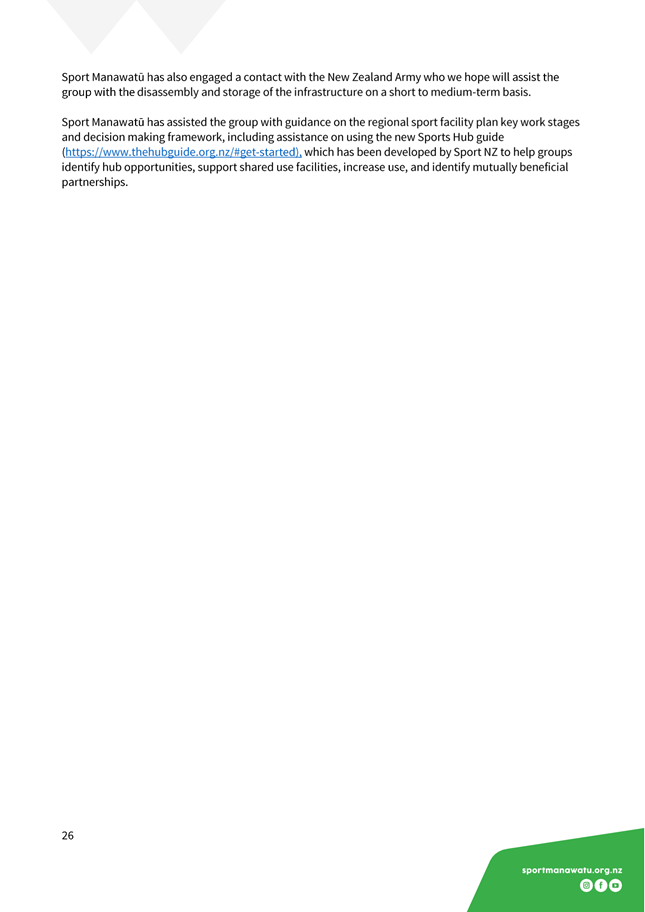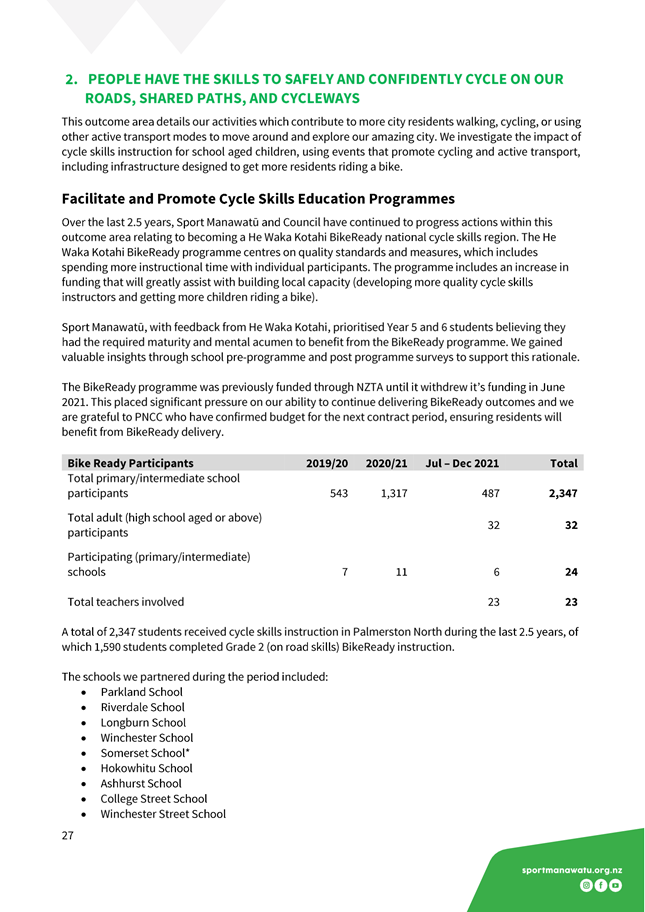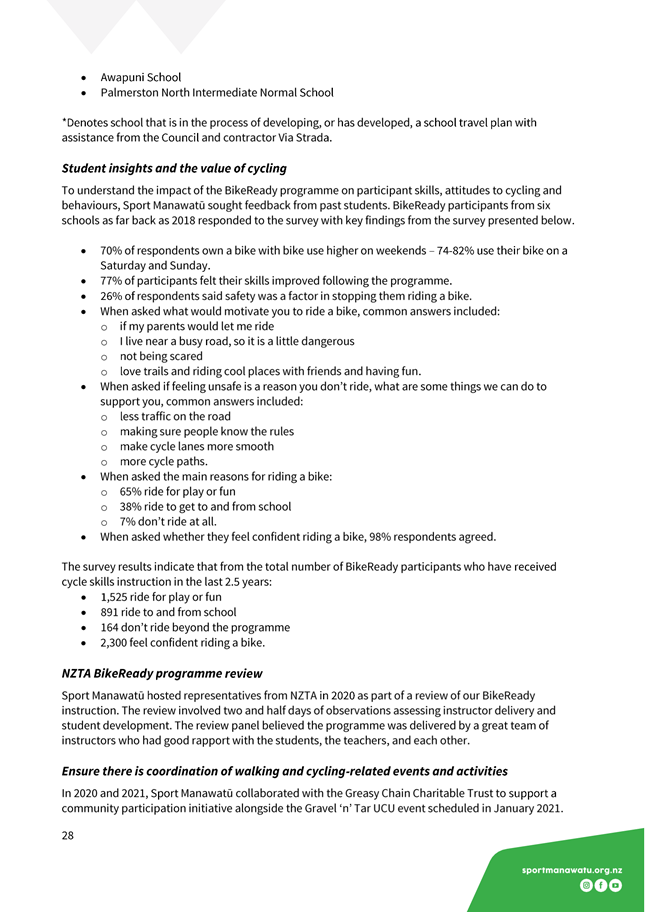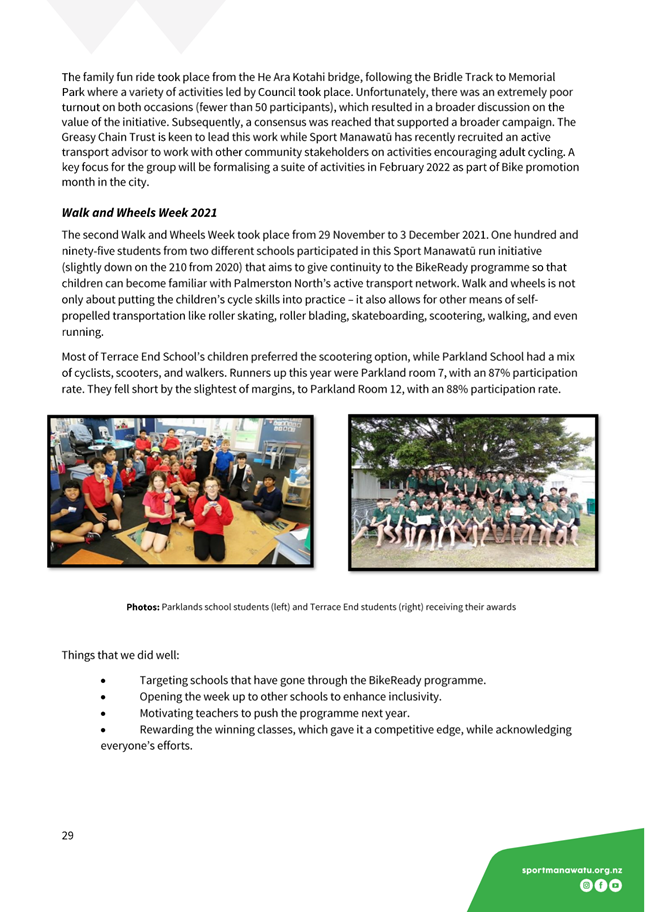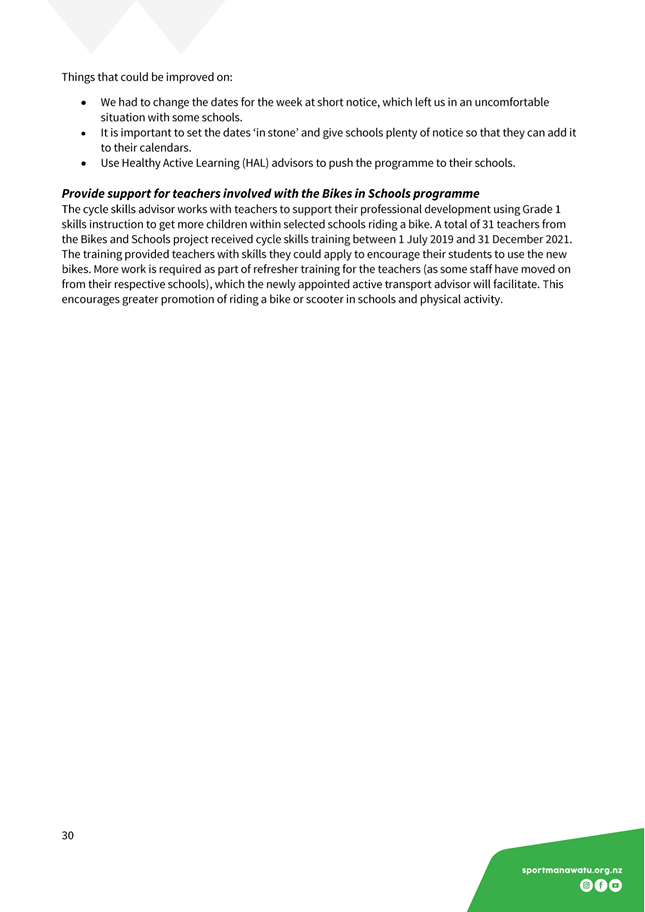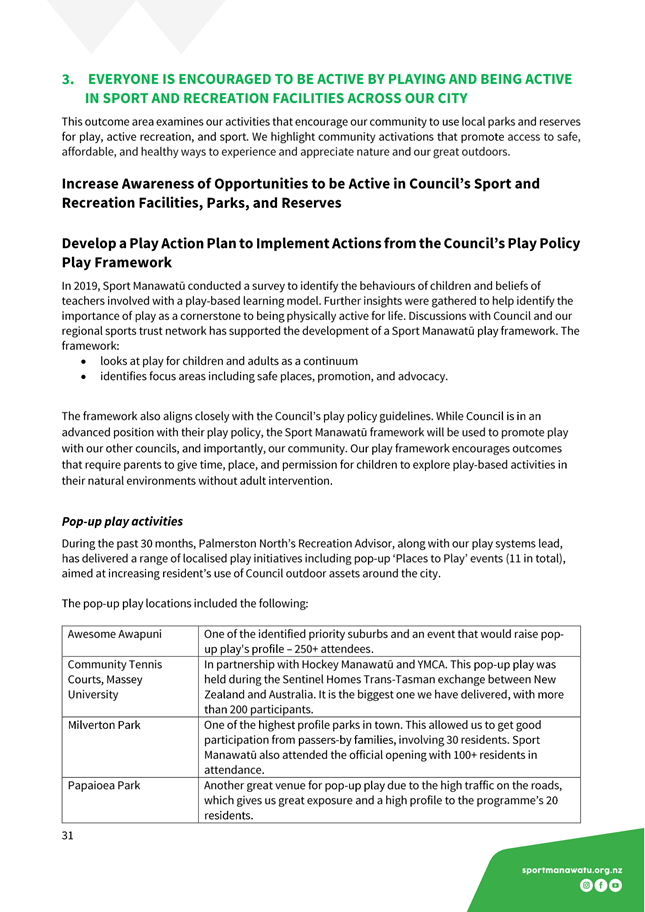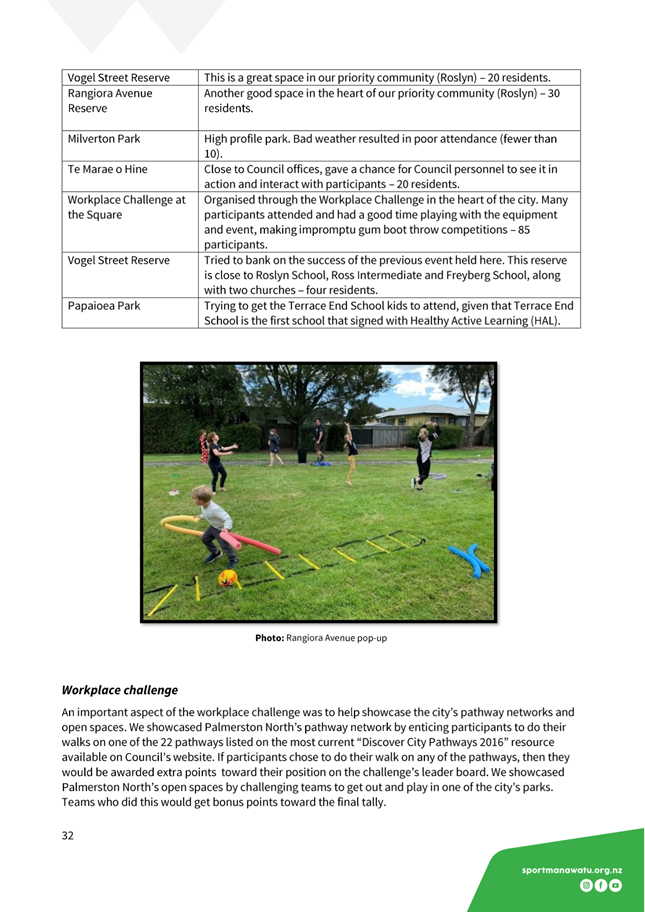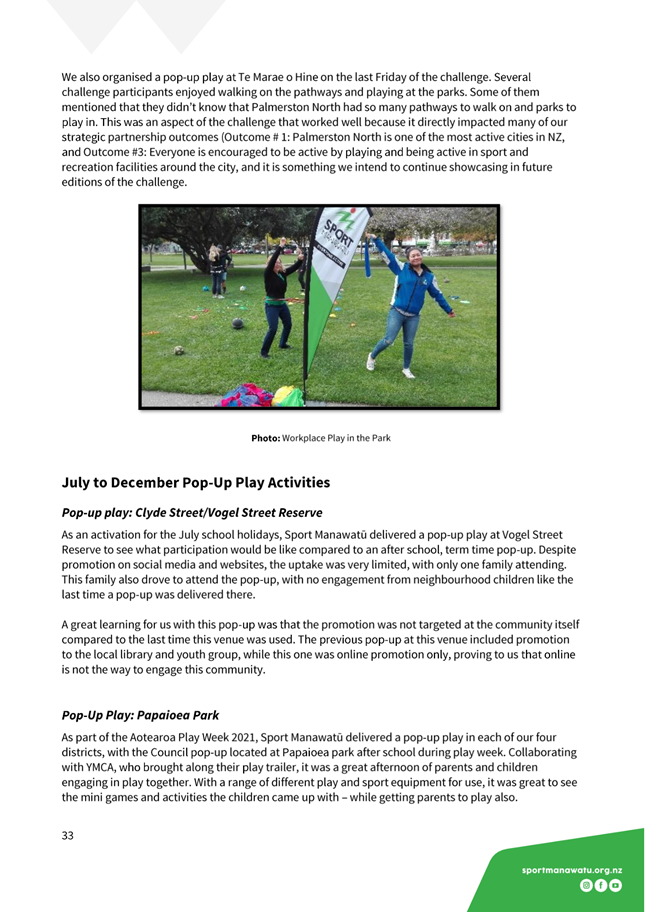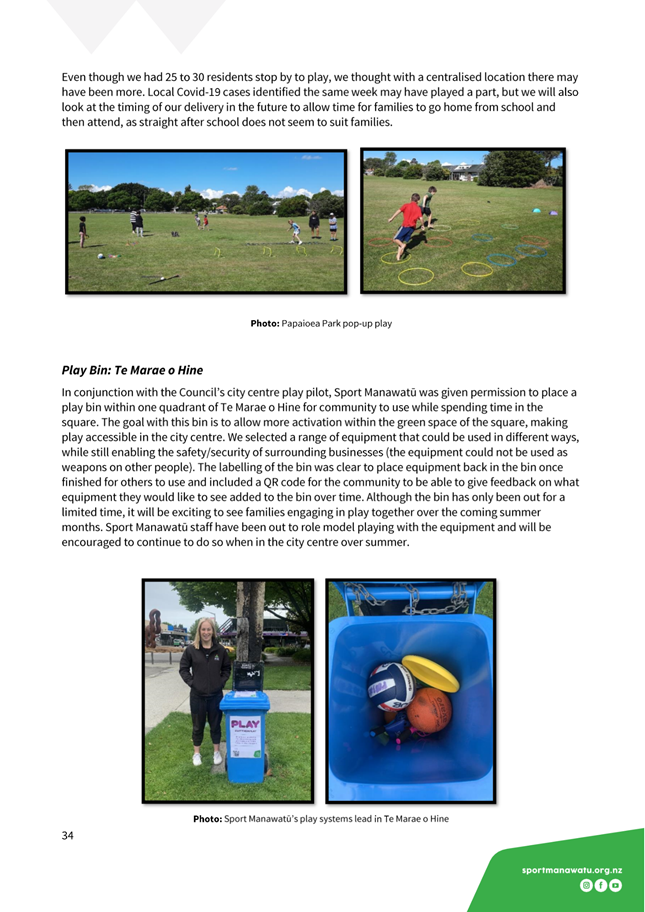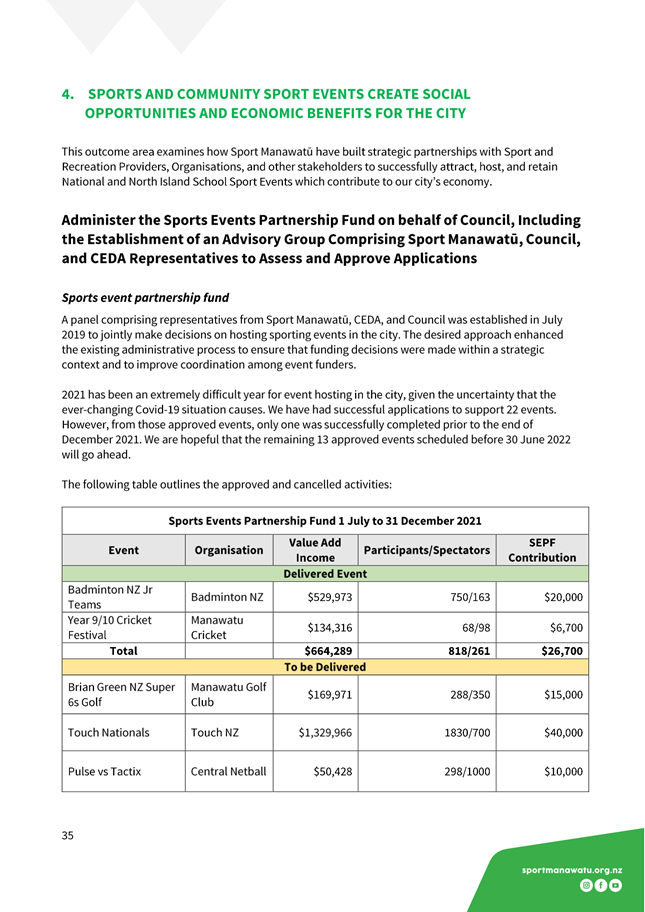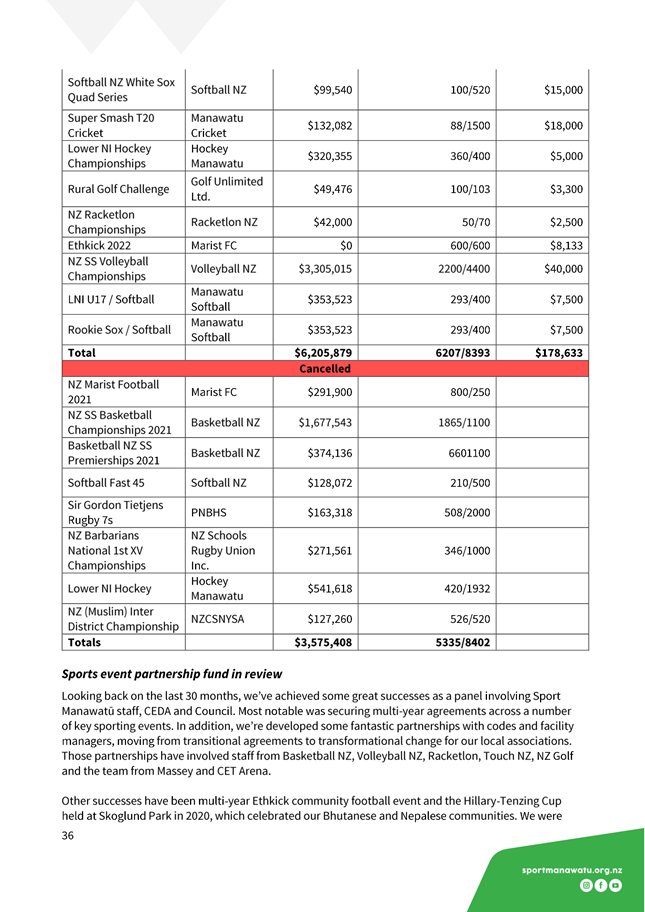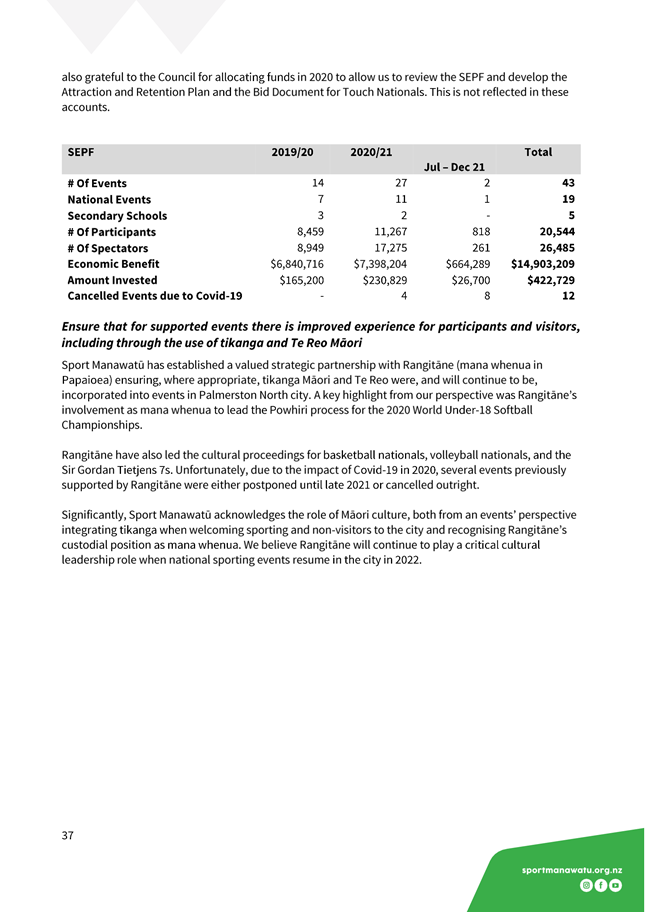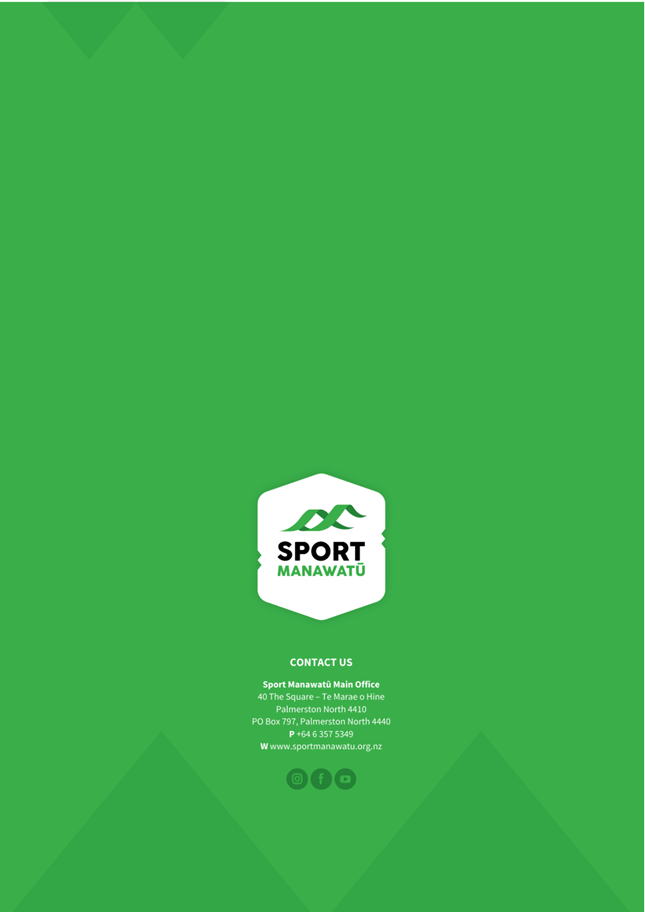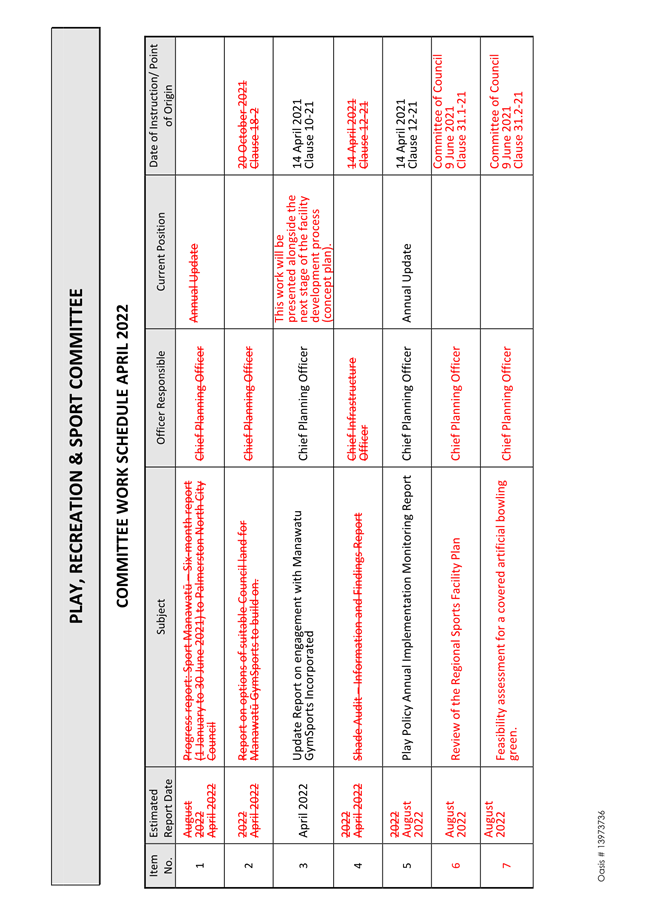Play, Recreation & Sport
Committee
|
Billy Meehan (Chairperson)
|
|
Leonie Hapeta (Deputy Chairperson)
|
|
Grant Smith (The Mayor)
|
|
Brent Barrett
|
Patrick Handcock ONZM
|
|
Zulfiqar Butt
|
Karen Naylor
|
|
Vaughan Dennison
|
Bruno Petrenas
|
|
Lew Findlay QSM
|
|
Play, Recreation & Sport
Committee MEETING
27 April 2022
Order of Business
1. Apologies
2. Notification
of Additional Items
Pursuant to Sections 46A(7) and
46A(7A) of the Local Government Official Information and Meetings Act 1987, to
receive the Chairperson’s explanation that specified item(s), which do
not appear on the Agenda of this meeting and/or the meeting to be held with the
public excluded, will be discussed.
Any additions in accordance with
Section 46A(7) must be approved by resolution with an explanation as to why
they cannot be delayed until a future meeting.
Any additions in accordance with
Section 46A(7A) may be received or referred to a subsequent meeting for further
discussion. No resolution, decision or recommendation can be made in
respect of a minor item.
3. Declarations
of Interest (if any)
Members are reminded of their duty
to give a general notice of any interest of items to be considered on this
agenda and the need to declare these interests.
4. Public
Comment
To receive comments from members of
the public on matters specified on this Agenda or, if time permits, on other
Committee matters.
(NOTE: If
the Committee wishes to consider or discuss any issue raised that is not
specified on the Agenda, other than to receive the comment made or refer it to
the Chief Executive, then a resolution will need to be made in accordance with
clause 2 above.)
5. Presentation
- Manawatū Triathlon Festival Page 7
6. Confirmation
of Minutes Page 9
“That the minutes of the Play,
Recreation & Sport Committee meeting of 23 February 2022 Part I Public be
confirmed as a true and correct record.”
7. Manawatū
GymSports' Facility Concept Outline for a Proposed New Gymnastics Facility -
Regional Sport Facility Plan Steering Group's Recommendation on Next Steps Page 13
Memorandum, presented by Julie
Macdonald, Strategy & Policy Manager.
8. Manawatū
GymSports' Regional Facility Proposal - Council Land Options Page 33
Memorandum, presented by Kathy
Dever-Tod, Group Manager - Parks and Logistics.
9. Results
of the 2022 Audit of Shade Provision in Parks Page 55
Memorandum, presented by Kathy
Dever-Tod, Group Manager - Parks and Logistics.
10. Progress Report: Sport
Manawatū - Six-month Report (1 July - 31 December 2021) to the Palmerston
North City Council Page 65
Memorandum, presented by Julie
Macdonald, Strategy & Policy Manager.
11. Committee Work
Schedule Page 107
12. Exclusion of Public
|
|
To be moved:
“That the
public be excluded from the following parts of the proceedings of this meeting
listed in the table below.
The general
subject of each matter to be considered while the public is excluded, the
reason for passing this resolution in relation to each matter, and the
specific grounds under Section 48(1) of the Local Government Official
Information and Meetings Act 1987 for the passing of this resolution are as
follows:
|
General subject of each matter to be
considered
|
Reason for passing this resolution in
relation to each matter
|
Ground(s) under Section 48(1) for passing
this resolution
|
|
|
|
|
|
|
|
|
|
This
resolution is made in reliance on Section 48(1)(a) of the Local Government
Official Information and Meetings Act 1987 and the particular interest or
interests protected by Section 6 or Section 7 of that Act which would be
prejudiced by the holding of the whole or the relevant part of the
proceedings of the meeting in public as stated in the above table.
Also that the
persons listed below be permitted to remain after the public has been
excluded for the reasons stated.
[Add Third
Parties], because of their knowledge and ability to assist the
meeting in speaking to their report/s [or other matters as specified] and
answering questions, noting that such person/s will be present at the meeting
only for the items that relate to their respective report/s [or matters as
specified].
|
Presentation
TO: Play,
Recreation & Sport Committee
MEETING DATE: 27
April 2022
TITLE: Presentation
- Manawatū Triathlon Festival
RECOMMENDATION(S) TO Play, Recreation & Sport Committee
1. That the
Play, Recreation & Sport Committee receive the presentation for
information.
Mr Mark Evans, Race Director, Manawatū Triathlon Festival
will outline the 3-day multi-sport event which will be held in various
locations across Palmerston North from 16-18 December this year.
Attachments
Nil
Palmerston North City Council
Minutes of
the Play, Recreation & Sport Committee Meeting Part I Public, held in the Council
Chamber, First Floor, Civic Administration Building, 32 The Square, Palmerston
North on 23 February 2022, commencing at 1:02 pm.
|
Members
Present:
|
Councillor Billy Meehan (in the Chair),
The Mayor (Grant Smith) and Councillors Leonie Hapeta, Brent Barrett,
Zulfiqar Butt, Vaughan Dennison, Patrick Handcock ONZM, and Bruno Petrenas.
|
|
Non Members:
|
Councillors Rachel Bowen, Renee Dingwall,
Lorna Johnson and Orphée Mickalad.
|
|
Apologies:
|
Councillors Karen Naylor and Susan Baty (late arrival on
Council business), Councillors Rachel Bowen (early departure) and Aleisha
Rutherford.
|
Councillor Rachel
Bowen left the meeting at 1:44 pm during consideration of
clause 2. She was not present for clauses 2 to 6 inclusive.
Councillors Karen
Naylor and Susan Baty entered the meeting at 2:06 pm during consideration of clause 3. They were not present for
clauses 1 and 2.
|
1-22
|
Apologies
|
|
|
Moved Billy Meehan, seconded Patrick Handcock ONZM.
The
COMMITTEE RESOLVED
1. That
the Committee receive the apologies.
|
|
|
Clause 1-22 above was carried 13 votes to 0.
|
|
2-22
|
Presentation Manawatū Cricket Association
Presentation by James
Lovegrove, General Manager.
Councillor
Rachel Bowen left the meeting at 1.44 pm.
James Lovegrove gave an
overview of Manawatū Cricket Association’s Strategic Plan:
2020-2023, he commented on the following:
- 125 years
of partnership and a 10-year project to bring First Class Cricket back to
Palmy
- 10 Year
project: achievements
- Participation,
Development, Enjoyment, Success
- The future
projects
- Challenges
for community sport
|
|
|
Moved
Billy Meehan, seconded Patrick Handcock ONZM.
The COMMITTEE RESOLVED
1. That the Play, Recreation & Sport Committee
receive the presentation for information.
|
|
|
Clause 2-22 above was
carried 12 votes to 0.
|
|
3-22
|
Presentation - Manawatū Rugby Union community
updates
Presentation by Andrea
Jackson, Chief Executive and Shaun Eade, Business
& Marketing Development Manager.
Councillors
Karen Naylor and Susan Baty entered the meeting at 2.06 pm.
Andrea Jackson and Shaun Eade
outlined the Manawatū Rugby Union’s (MRU) three strategic
priorities, she highlighted:
- the
importance of the 5,550 community rugby players, including coaches, referees,
families, and the two performance teams, the Cyclones and Turbos
- the
community connections who support the MRU and make sure our teams, players
and whanau continue to strive
- on and
off-field winning means the leadership in our community goes far beyond the
scoreboards and results, it is all about people and their work in the
community
- the
Community Rugby statistics
|
|
|
Moved
Billy Meehan, seconded Patrick Handcock ONZM.
The COMMITTEE RESOLVED
1. That the Play, Recreation & Sport Committee
receive the presentation for information.
|
|
|
Clause 3-22 above was
carried 12 votes to 0.
|
|
4-22
|
Presentation - Sport Manawatū updates
Presentation by Trevor
Shailer, Chief Executive and Brad Cassidy, General Manager- Partnerships.
Trevor Shailer and Brad
Cassady updated the Committee on the following:
- the impact
of COVID 19 on local and national sport and the challenges and changes
required to comply with health restrictions
- the
decrease in participation and funding applications due to the impact of
Covid.
- review of
the Safety Plans to resume the community activities and the national events
plans
- Sport
Manawatū updates on staff appointments such as new board members and the
increase of the staff numbers to 34; virtual event planning; and healthy
active learning
|
|
|
Moved Billy Meehan, seconded Vaughan Dennison.
The COMMITTEE
RESOLVED
1. That the Play, Recreation & Sport
Committee receive the presentation for information.
|
|
|
Clause 4-22
above was carried 14 votes to 0.
|
|
5-22
|
Confirmation of Minutes
|
|
|
Moved Vaughan Dennison, seconded Brent Barrett.
The
COMMITTEE RESOLVED
That the minutes of the Play, Recreation & Sport
Committee meeting of 20 October 2021 Part I Public be confirmed as a true and
correct record.
|
|
|
Clause 5-22 above was carried 14 votes to 0.
|
|
6-22
|
Committee Work Schedule
|
|
|
Moved
Billy Meehan, seconded Vaughan Dennison.
The COMMITTEE RESOLVED
That the Play, Recreation & Sport Committee receive
its Work Schedule dated February 2022.
|
|
|
Clause 6-22 above was
carried 14 votes to 0.
|
The meeting finished at 2:30 pm.
Confirmed 27 April 2022
Chairperson
Memorandum
TO: Play,
Recreation & Sport Committee
MEETING DATE: 27
April 2022
TITLE: Manawatū
GymSports' Facility Concept Outline for a Proposed New Gymnastics Facility -
Regional Sport Facility Plan Steering Group's Recommendation on Next Steps
Presented By: Julie
Macdonald, Strategy & Policy Manager
APPROVED BY: David
Murphy, Chief Planning Officer
RECOMMENDATION(S)
TO COMMITTEE
1. That the
Committee receive the Regional Sport Facility Plan Steering Group’s
report on the assessment of the Manawatū GymSports’ Facility Concept
Outline for a regional gymnastics facility in
Palmerston North, presented to the Play, Recreation & Sport Committee on 27
April 2022.
1. ISSUE
1.1 Manawatū
GymSports Inc. (GymSports) has finalised a Facility Concept Outline (FCO) for a
proposed new regional-level gymnastics facility. The requirement to prepare an
FCO is the first stage of the investment decision-making
process in the Manawatū-Whanganui Regional
Sport Facility Plan (the RSFP).
1.2 GymSports
indicated in a presentation to the Committee in April 2021 that it would like
Council’s support for its facility proposal through the provision of a
land lease.
1.3 As
the proposal is for a regional-level sports facility, the RSFP Steering Group
has assessed the FCO using the RSFP guidance. Following this assessment, the
RSFP Steering Group recommends that the proposal proceeds to the next step of
the investment decision-making process - a Preliminary Feasibility Assessment.
1.4 The
RSFP Steering Group’s assessment, which includes GymSports’ FCO, is
attachment 1.
2. BACKGROUND
2.1 The
Council endorsed the RSFP in 2018 to guide sports facility planning and to
coordinate sport and recreation facility provision across the region. It
provides a high-level strategic framework and takes a network-wide approach.
2.2 The
RSFP includes a facility investment decision-making process which provides a
mechanism to assess all potential facility projects so that decision-makers
(e.g. funders and the Councils) have access to independent, detailed and
accurate information. This process reinforces a ‘needs-based’
planning approach (rather than one that responds to ‘wants’).
2.3 The
Council contributes an annual operational grant to Sport Manawatū to
coordinate the implementation of the RSFP. This grant is included in the
funding agreement between the Council and Sport Manawatū.
2.4 The
RSFP Steering Group is made up of staff from the seven Councils in the region,
Regional Sports Trust staff from Whanganui and Manawatū, and Sport New
Zealand Ihi Aotearoa.
2.5 Sport
Manawatū is the lead organisation overseeing the
implementation of the RSFP. It guides proponent groups (in this case,
GymSports) through the process when a proposal meets the definition of a
‘regional facility’. A regional facility is one with the ability to
host inter-regional and internal regional competitions and/or serves as a
regional high-performance training hub for one or more sports codes. These
types of facilities service a catchment from within a 90-minute drive time.
2.6 The
investment decision-making process contributes to broader decision-making
processes for sports facility planning. In summary, this process involves:

1. Facility
Concept Outline – this is a high-level summary of the proposed
facilities’ key facts. It includes an assessment of the degree of
strategic alignment with key sports facility plans, demonstration of the
perceived need for the facility (outlining membership and participation numbers
and facility challenges), an indicative facility cost, preferred location and
proposed governance and management structures.
2. Preliminary
Feasibility Assessment – this work further tests the viability of the
Facility Concept Outline. This work is often referred to as a ‘needs
assessment’ or ‘demand assessment’ and confirms any immediate
challenges or opportunities. Part of the assessment also looks at identifying
partnership funding opportunities.
3. Detailed
Feasibility Assessment – a holistic examination of all areas of the
proposed facility development. This requires a range of inputs from
specialists in demographic analysis, sports facility planning, business
planning, concept design, governance and management.
4. Business
Case – an analysis of the financial implications of the proposal,
such as capital and operational costs.
2.7 The
feasibility stages of the process (the blue arrows) test the facility proposal
in more depth using specialist and independent sports facility consultant
advice. At the end of each stage of work, the RSFP Steering Group is required
to assess the work against specific ‘gateway’ criteria to decide if
there is merit in proceeding with the facility proposal. The purpose of
applying these criteria is to ensure all sports facility proposals in the
region are evaluated in a structured and consistent way using the facility
investment decision-making process.
2.8 The
RSFP process is needed because regional sports facilities are multi-million
dollar projects involving a wide range of stakeholders. The ongoing operational
and asset management costs also need to be considered alongside other
investment priorities. Importantly, if a facility proponent group is seeking
external funding then the evidence of a need for the facility demonstrated
through the feasibility assessments provides critical supporting information
for funding applications.
2.9 The
RSFP Steering Group assessed the proposal against the gateway criteria outlined
in the RSFP. These criteria provide the basis for a recommendation on whether
the proposal should proceed to the next stage of the process (i.e. the
preparation of a Preliminary Feasibility Assessment) or if further
exploration of the proposal outlined in the FCO should stop.
GymSports approach to the Council
2.10 GymSports
made a presentation to the April 2021 meeting of the Play, Sport and Recreation
Committee outlining its achievements and current facility challenges. GymSports
is working on a regional gymnastics facility project that aligns with the
Gymnastics NZ National Facilities Strategy and will provide better local and
regional opportunities for competitive and recreational gymsports.
2.11 In October
2021 staff gave an update to the Play, Sport and Recreation Committee on
progress with an initial FCO prepared by GymSports. A subsequent recommendation
was:
“That the Chief Executive report back to the Play,
Recreation and Sport Committee with options of suitable Council land for
Manawatū GymSports to build on.”
2.12 A report
responding to the recommendation on suitable Council land options is provided
separately to the Committee.
2.13 Since late
2021, Council and Sport Manawatū staff have been working with GymSports,
and Gymnastics New Zealand (GNZ), to finalise the FCO to ensure the RSFP
information requirements are met.
3. rsfp STEERING GROUP aSSESSMENT of the facility
concept outline
3.1 The
RSFP Steering Group’s assessment is attachment 1. The following
criteria were applied to assess the FCO:
- Degree of alignment the
facility proposal has with national, regional and local plans and strategies
(including the Regional Sports Facility Plan).
- Degree to which the projected
needs of the sport are met.
- Track record of the proponent
organisation.
3.2 Staff
have reviewed the RSFP Steering Group’s assessment of GymSports’
FCO and agree with its recommendations that the FCO should progress to the next
stage of feasibility for further exploration.
4. next steps
4.1 GymSports
is not requesting specific financial support from the Council at this time, to
either fund future feasibility/investigative stages required by the RSFP
process, or to contribute to the facility’s capital costs. GymSports has
indicated that it will seek external funding for the feasibility stages of work
identified in the RSFP process.
4.2 Should
the GymSports’ facility proposal proceeds to the preliminary and/or
detailed feasibility assessment stages, Council staff will provide advice from
a number of activity areas. Staff may also be involved in a project working
team for any future feasibility assessments alongside Sport Manawatū,
GymSports and Gymnastics NZ (the national sports organisation). This
collaborative stakeholder approach has been adopted with the feasibility work
for a regional level artificial football turf and the covered bowling green.
4.3 If
the proposal proceeds to the feasibility assessment stages, the findings from
other sports facility planning programmes may inform the decision-making
processes. These programmes are:
- The current review of the City
sections of the Regional Sport Facilities Plan
- the upcoming Arena
Manawatū Master Plan review
- a needs assessment for indoor
sports scheduled to start in 2023/24.
4.4 Staff
will continue to be involved as a member of the RSFP Steering Group. At the
completion of the Preliminary Feasibility Assessment, the Steering Group will
further consider the proposal’s merits and make a recommendation to the
proponent group about continuing to the next stage. The Committee will receive
an update on these future stages of work as necessary.
5. Compliance and administration
|
Does the Committee have
delegated authority to decide?
If Yes quote relevant clause(s)
from Delegations Manual 167.2
|
Yes
|
|
Are the decisions significant?
|
No
|
|
If they are significant do, they
affect land or a body of water?
|
No
|
|
Can this decision only be made
through a 10 Year Plan?
|
No
|
|
Does this decision require
consultation through the Special Consultative procedure?
|
No
|
|
Is there funding in the current
Annual Plan for these actions?
|
Yes
|
|
Are the recommendations
inconsistent with any of Council’s policies or plans?
|
No
|
|
The recommendations contribute
to Goal 2: A Creative and Exciting City
|
|
The recommendations contribute
to the achievement of action/actions in Active Communities
The action is: Contribute to
pre-feasibility or needs assessment work (as required by Council’s
commitment to the Regional Sports Facilities Plan)
|
|
Contribution to strategic
direction and to the social, economic, environmental and cultural well-being
|
The RSFP was endorsed by Council
in 2018 and since then the investment decision-making process has guided several
sports facility proposals. Applying this process consistently ensures that
the Council’s strategic direction is a key consideration. Sports
facilities contribute to social well-being as they provide spaces for people
to be physically active.
|
|
|
|
Attachments
|
1.
|
Manawatū-Whanganui
Regional Sports Facility Plan Steering Group – Assessment of Manawatū
GymSports’ Facility Concept Outline ⇩ 
|
|
Memorandum
TO: Play,
Recreation & Sport Committee
MEETING DATE: 27
April 2022
TITLE: Manawatū
GymSports' Regional Facility Proposal - Council Land Options
Presented By: Kathy
Dever-Tod, Group Manager - Parks and Logistics
APPROVED BY: Sarah
Sinclair, Chief Infrastructure Officer
RECOMMENDATION(S)
TO Council
1. That
Council note the identified Council land options for the Manawatū
GymSports’ Regional Facility Proposal.
2. That
Council include the list of identified Council land options in any
future decision-making process for the Manawatū GymSports’
Regional Facility Proposal.
1. ISSUE
1.1 Manawatū
GymSports (GymSports) presented to Council in October 2021, seeking space for a
facility of up to 2,500 m² with up to 70 associated carparks.
1.2 This
report assesses possible Council land options, at a desktop level, and
identifies the strengths and constraints of those options.
2. BACKGROUND
2.1 In
October 2021 Council resolved to assess suitable land options that Council may
have to accommodate the regional level facility GymSports are planning for, as
follows:
“That the Chief Executive report back to the
Play, Recreation and Sport Committee with options of suitable Council land for
Manawatū GymSports to build on.”
2.2 This
report addresses the above recommendation.
2.3 In
addition to this report, the wider needs and aspirations of GymSports are
contained within a separate report on the agenda of the April 2022 Play,
Recreation and Sport Committee titled “Manawatū Gymsports Facility
Concept Outline for a proposed new gymnastics facility - Regional Sports
Facility Plan Steering group recommendation”.
3. Criteria and methodology
3.1 A
working party was established to look at the criteria and assess options.
The working party was made up of representatives from:
· Sport Manawatū,
· GymSports New
Zealand,
· Manawatū GymSports
and
· Palmerston North
City Council officers.
3.2 The
criteria established by the working party were:
1. Space
– up to 10,000 m² depending on specific location factors
· Building - 2,500
m²,
· 75 carparks
–2,750 m²
· building setbacks
to sensitive adjoining uses of 10 m to 15 m and 4 m off any road frontage to
minimise the risk of resource consent issues.
2. Location/accessibility
– GymSports were open to options but preferred the city’s northern
side and ideally in the northeastern suburbs.
3. Site – GymSports
preference to have some profile and community presence so the site would ideally
have some road frontage or be situated in a positive and well-frequented space.
4. Adding value
– sites with other activities such as schools, playgrounds, pools or
other community recreation facilities would add value to GymSports holiday
programmes, their members/users’ experience and improve accessibility for
schools.
3.3 A
high-level desktop assessment was conducted. It was noted that options if any,
and their effects on other activities, would be considered in more detail at
later stages in the Regional Sports Facilities Decision Making Process.
3.4 The
working party considered land currently occupied by other activities, assuming
the sites were a viable option if the existing activities could potentially be
relocated at a relatively low cost, or through reorganisation of an overall
network of use, and the overall impact on the activity was acceptable.
4. Findings
4.1 Stormwater
Portfolio - Stormwater reserves were discounted as the primary purpose
of stormwater management would be impacted. No large unoccupied areas not
already serving a stormwater purpose were identified.
4.2 Water
Portfolio – Water properties are fully utilised for their primary
purpose of water supply and no land holdings with the space required are
available.
4.3 Wastewater
Portfolio – The area of Totara Road wastewater/industrial land,
which has a series of community leases on it, has a large area currently
unoccupied. This is site is constrained by major sewer lines but could
potentially accommodate a GymSports facility.
The wastewater treatment plant consent team advises it will
be up to 9 months before the required footprint for the new Wastewater
Treatment plant is firm enough to consider this location. No other wastewater
properties were identified.
4.4 Resource
Recovery Portfolio - no resource recovery or waste properties have
50,000 -10,000 m² of unoccupied land in a suitable location.
4.5 Transport
Portfolio - Transport hold several properties for road
improvements. These sites all have purposes such as intersection upgrades
and/or are too small to accommodate a facility requiring 5,000 - 10,000
m².
4.6 Strategic
Investment and Operational Properties Portfolio
4.6.1 The feasibility of
relocating The Depot and developing housing is being assessed in 2022 under
Programme 2040. The site is 3.4 ha including the recycling facility and
community centre. The GymSports facility would require 25 to 30% of the
site.
4.6.2 No other investment
or operational properties were identified as having the space in a suitable
location.
4.7 Arts
and Culture Portfolio – No Arts and Cultural properties were
identified as having a space suitable.
4.8 Parks
and Reserves Portfolio
4.8.1 Neighbourhood,
Historic/Cultural, Suburb and City Reserves are not suitable locations due to
the primary purpose of the land, and the size and nature of the facility
proposed.
4.8.2 Summerhill Reserve
was discounted as it was acquired as open space as mitigation to avoid
environmental court action against a subdivision.
4.8.3 Land purchased for
future extensions of the Kelvin Grove Cemetery was considered. The land
is unsuitable due to lack of a road frontage, requiring 300 m plus access and
services provision, a poor fit with the cemetery activity and the impacts on
the future capacity of the cemetery.
4.8.4 Some sports fields
were identified with the potential to accommodate the GymSports facility.
None were a clear and straightforward fit with the criteria.
4.8.5 All sports fields
options would need careful consideration for effects on activities at the
location in question and/or effects on the overall capacity of the sports
fields network.
4.8.6 The assessment of
the sports field needs presented to the Council in October 2020 to inform
decisions on the proposed artificial turf found:
· Population growth
will generate increased participation in winter sports codes and changes in
approach that will encourage greater participation.
· Football and rugby
union sporting codes currently must compromise their delivery as they cannot
consistently access enough training venues.
· Modelling of
future field requirements shows an undersupply in current and future weekday
training capacity.
4.8.7 Council has
planning underway that may increase the supply of sports fields through
Programme 1906 – Artificial turf detailed feasibility assessment and
Programme 1133 for design and construction of an artificial field[1].
4.9 Sports
fields that could be explored in more detail are:
|
Sports
field
|
Location
|
Comment
|
|
Alexander
Park
|
Awapuni
|
Not
currently used as a sports field. No changing or toilet facilities. No
street frontage and not preferred by GymSports.
|
|
Bill
Brown Park
|
Takaro
|
Would
affect training and/or playing field space.
|
|
Celaeno
Park
|
Kelvin
Grove
|
Requires
on-site assessment and to-scale drawings to determine if affects the playing
field. May conflict with other field organisation/community centre
options assessment.
|
|
Colquhoun
Park
|
Milson
|
Affect
a training/playing field or 2 tennis courts. May conflict with softball
development plans.
|
|
Coronation
Park
|
Takaro
|
Would
affect training and/or playing field space.
|
|
Hokowhitu
Domain
|
Hokowhitu
|
Would
affect a playing field space and a bowling green
|
|
Manawaroa
and Ongley Parks
|
Awapuni
|
Would
affect training and/or playing field space
|
|
Vautier
Park
|
Roslyn
|
Tight
for space (in front of Redsox or between car parking areas). Traffic and car
parking assessment critical. Implications for sightlines and
visibility.
|
4.9.1 Aerial photographs
and an overview of the strengths and weaknesses of the options are shown in
Attachment 1.
4.10 Arena
Manawatū - The Arena Manawatū Masterplan is to be
reviewed. Consideration should be given to the potential for GymSports to
relocate to Arena. It is noted that the GymSports facility space
requirements for a regional facility are significantly greater than previous
conversations with Arena Manawatu management indicated, and the GymSports
requirements do not allow for multi-sports use.
4.11 Urban
Growth areas
4.11.1 Council could consider future
land planning in urban growth areas.
4.11.2 The urban growth areas likely
to progress in the next 2 to 5 years are Kikiwhenua, Ashhurst, Whakarongo, and
Aokautere. Private plan changes at Whiskey Creek or subsets of
Kakatangiata may also progress if private development progresses.
4.11.3 Purchasing new reserve
land in residentially zoned greenfield areas in the order of $225 per m²
or $1.58 million for 7,000 m² would be a less cost-effective option than
purchasing vacant industrially zoned land at approximately $60 per m² or
$420,000 for 7,000 m².
5. land owned by others
5.1 During
the assessment some Ministry of Education (school) sites and private land e.g.
industrial properties were discussed.
5.2 No
assessment of these sites was undertaken as they were outside the scope of this
report. These options would be properly considered in future stages of the
Regional Sports Facilities Plan Decision Making process.
6. Compliance and administration
|
Does the Committee have
delegated authority to decide
|
No
|
|
Are the decisions significant?
|
No
|
|
If they are significant do, they
affect land or a body of water?
|
No
|
|
Can this decision only be made
through a 10 Year Plan?
|
No
|
|
Does this decision require consultation
through the Special Consultative procedure?
|
No
|
|
Is there funding in the current
Annual Plan for these actions?
|
No
|
|
Are the recommendations
inconsistent with any of the Council’s policies or plans?
|
No
|
|
The recommendations contribute
to Goal 2: A Creative and Exciting City
|
|
The recommendations contribute
to the achievement of action/actions in Active
Communities
The action is: Work with other
sport and recreation providers and adjoining Councils
Partner with Sport Manawatū
to deliver play, active recreation and sport services to meet community
outcomes sought by the Council including the co-ordination of the Regional
Sports Facility Plan, Active Communities and the Sports Event Partnership
Funds
Contribute to pre-feasibility or
needs assessment work (as required by Council’s commitment to the
Regional Sports Facilities Plan)
|
|
Contribution to strategic
direction and the social, economic, environmental and cultural well-being
|
Provision of council-owned land
options supports consideration of a regional gymsports facility for the
community that enjoys and benefits from that health and social connectivity
the facility supports.
A regional facility may attract
some economic benefit as a destination for regional activities.
|
|
|
|
Attachments
|
1.
|
GymSports site assessment summaries ⇩ 
|
|
Memorandum
TO: Play,
Recreation & Sport Committee
MEETING DATE: 27
April 2022
TITLE: Results
of the 2022 Audit of Shade Provision in Parks
Presented By: Kathy
Dever-Tod, Group Manager - Parks and Logistics
APPROVED BY: Sarah
Sinclair, Chief Infrastructure Officer
RECOMMENDATION(S)
TO PLAY, RECREATION & SPORT COMMITTEE
1. That the
Committee receive the memorandum titled ‘Results of the 2022 Audit of
Shade Provision in Parks’ presented to the Play, Recreation & Sport Committee
on 27 April 2022.
1. ISSUE
1.1 Council
adopted a Sun Protection Policy in 2010.
1.2 One
of the actions within the policy is a three-yearly shade audit of council-owned
parks, gardens and recreational facilities.
1.3 This
report presents the results of the 2022 audit of shade in parks.
2. BACKGROUND
2.1 The
aim of the Sun Protection Policy is for the council to contribute to a
reduction in the incidence of skin cancer within Palmerston North by improving
shade and other sun protection measures throughout the City.
2.2 The
policy outlines that by acting in three key areas the City Council will
minimise the incidence of excessive and harmful patterns of Ultraviolet
Radiation (UVR) exposure to residents of Palmerston North, namely.
· Council
as a consent authority
· Parks,
gardens and recreational facilities owned and operated by the City Council
· Promotion and education of sun
protection.
2.3 Council
policy is to establish shade trees in parks and reserves, especially where
children’s play areas are being provided.
2.4 The
shade audit is the mechanism by which the level of shade provided is assessed.
Recommendations arising from shade audits are prioritised and incorporated into
the triennial Asset Management Plan process.
3. pARK
Shade Audit Methodology
3.1 In
January 2022 parks were assessed and the level of shade was categorised as
follows:
· Plenty of shade
· Some shade
· No shade
The
type of shade, natural or artificial, was recorded.
3.2 Shade
provision of playgrounds was assessed and recorded as follows:
· Some Shade
· No
shade
3.3 Newly
planted shade trees within parks were noted.
4. Shade
Audit Results
4.1 The
2022 park shade audit assessed 79 neighbourhood parks and sports fields, and 47
playgrounds within these parks. The list of parks audited is contained in
Attachment 1.
4.2 A
summary of the shade audit results is presented in Table 1.
|
Shade
|
Number of Parks
|
Artificial shade
|
Sports fields
|
|
Plenty
|
30
|
2
|
4
|
|
Some shade -
with new trees
|
32
|
2
|
8
|
|
Some shade-
with no new trees
|
9
|
1
|
1
|
|
No shade - with
new trees
|
5
|
0
|
0
|
|
No shade and no
new trees
|
3
|
0
|
1
|
|
Total Parks
|
79
|
5
|
14
|
Table 1: Whole Park Shade Audit Results 2022
4.3 Of
the 79 parks audited, 38% (30) were assessed as having plenty of shade.
Only 3 parks were assessed as not having ‘plenty’ of shade and no
newly planted shade trees:
· Bunnythorpe
Recreation Grounds
· Clausen
Reserve
· Dahlstrom Reserve.
4.4 5
of the parks audited have artificial shade. All parks with artificial
shade also have natural shade, except Raleigh Reserve.
4.5 14
of the 79 parks audited have sports fields. All sports fields were
assessed as having plenty or some shade except for the Bunnythorpe Recreation
Grounds.
4.6 A
summary of the playground shade audit results is presented in Table 2.
|
Shade
|
Playgrounds
|
New Trees Planted
|
No New Trees Planted
|
|
Some
|
31
|
22
|
9
|
|
None
|
16
|
13
|
3
|
|
Total Parks
|
47
|
35
|
11
|
Table 2: Playground
Shade Audit Results 2022
4.7 2/3
of playgrounds audited have some shade. All playgrounds have either some
shade and/or new trees planted within the park; except the following three
parks:
· Raleigh
Reserve (has artificial)
· Clausen
Reserve
· Dahlstrom Reserve
4.8 The
audit confirms that 49 parks and 16 playgrounds require tree growth and/or more
trees to meet council policy of ‘establishing shade trees in parks and
reserves, especially where children’s play areas are being
provided’.
5. SHADE
TREE PLANTING PROGRAMME
5.1 Improvements
to shade provision in parks are funded through Long-Term Plan 2021-2031
Programme 1099 - Parks and Reserves – Shade Development.
5.2 Council
policy is to provide natural shading options where new shade opportunities
arise, as well as when replacing existing artificial shade.
5.3 The
policy direction is consistent with council strategy regarding the environment.
Replacing artificial shading with trees reduces reliance on materials
containing fossil fuels, such as shade cloth. Trees help reduce atmospheric
CO² and stormwater runoff.
5.4 Each
year $10K within Programme 1099 is set aside for tree planting. Over the past
three years, the funding has been used to plant new trees in several
parks.
5.5 The
audit results have been used to prioritise shade tree planting in parks based
on the current level of shade, and prioritising parks in the following order:
playgrounds, sports fields than all other parks. The objective is for all
parks to have ‘plenty’ of shade.
5.6 Table
4 provides a summary of the number of parks within each tree planting priority
group. Attachment 1 lists the 79 parks audited in tree planting priority
order.
|
Priority
|
Shade Category
|
Number of Parks
|
|
1
|
Playgrounds NO
shade and no trees planted
|
3
|
|
2
|
Sports fields
NO shade and no trees planted
|
1
|
|
3
|
Other parks NO
shade and no trees planted
|
0
|
|
4
|
Playgrounds NO
shade (some trees planted)
|
13
|
|
5
|
Playgrounds
SOME shade (no trees planted)
|
9
|
|
6
|
Playgrounds
SOME shade (some trees planted)
|
22
|
|
7
|
Sports fields
SOME shade (no trees planted)
|
1
|
|
8
|
Sports fields
SOME shade (some trees planted)
|
1
|
|
9
|
Other parks NO
shade (some trees planted)
|
2
|
|
10
|
Other parks
SOME shade (no trees planted)
|
5
|
|
11
|
Other parks
SOME shade (some trees planted)
|
6
|
|
12
|
Plenty of Shade
|
16
|
|
|
Total Parks
|
79
|
Table 3: Park
prioritisation for tree planting to achieve ‘Plenty of Shade’
5.7 The
average cost to plant a large specimen shade tree in a park, including labour,
plant and materials (fertiliser, mulch, stakes and ties), is $250. The current
budget provision of $10,000 per annum enables Council to plant 40 new trees
each year.
5.8 Priority
1 parks will be planted with new trees in Autumn 2022. The priority 2
park, Bunnythorpe Recreation Grounds, will be included in the 2022/23
programme, to allow time for officers to consult with the Bunnythorpe Community
Centre Association on a planting programme for the wider park. Priority 4
parks will be addressed over the 2021/22 and 2022/23 financial years.
5.9 On
average, it takes five years of growth before a new tree provides a noticeable
level of shade in a park. Once planted, the operating budget is used to
water trees over the summer months and to undertake other tasks such as staking
and mulching, to optimise tree growth.
5.10 There is
an ongoing need to replant young trees due to the high rate of loss, largely
because of theft and vandalism. Other factors contributing to the loss of young
trees include adverse weather and damage whilst undertaking other parks
maintenance activities, such as mowing. Tree replacements are
funded annually from Programme 1827 Local Reserve Renewals and Programme 1829
– Sports field Renewals.
5.11 On
average, the minimum level of trees required to shade the playground and
seating in a small neighbourhood or special character reserve, in addition to
existing vegetation, is 4 trees and a larger suburb reserve or sports fields
park requires an additional 14 shade trees.
5.12 Based on
the 2022 audit results, 432 new shade trees are required to meet the objective
of plenty of shade in parks and reserves; 180 trees in small reserves and 252
in larger reserves and sports fields. At the current level of funding in
Programme 1099, it will take 10 years to complete the planting programme and a
further five years of growth before all parks and reserves could be assessed as
having plenty of shade.
5.13 The shade
audit results will be used to inform shade tree funding options (short, medium
and long term), for consideration as part of the asset management planning
process.
5.14 The shade audit
methodology will enable Council to cost-effectively assess the changing level
of shade in parks over time, including the impacts of the shade programme.
6. NEXT
STEPS
6.1 Attachment
1 used the order of priority for the planting of new shade trees in parks and
reserves.
6.2 Programme
1099 was used to plant shade trees in Priority 1 and 4 parks in Autumn 2022.
7. Compliance
and administration
|
Does the Committee have
delegated authority to decide?
If Yes quote relevant clause(s)
from Delegations Manual
|
Yes
|
|
Are the decisions significant?
|
No
|
|
If they are significant, do they
affect land or a body of water?
|
|
|
Can this decision only be made
through a 10 Year Plan?
|
No
|
|
Does this decision require
consultation through the Special Consultative procedure?
|
No
|
|
Is there funding in the current
Annual Plan for these actions?
|
Yes
|
|
Are the recommendations
inconsistent with any of the Council’s policies or plans?
|
No
|
|
The recommendations contribute
to Goal 2: A Creative and Exciting City
|
|
The recommendations contribute
to the achievement of action/actions in Active
Communities
The action is: to provide and
maintain city reserves, local reserves and sports fields
|
|
Contribution to strategic
direction and to the social, economic, environmental and cultural well-being
|
Shade enables park users to be
active outdoors for long periods of time without undue exposure to
ultraviolet radiation. The provision of shade in reserves therefore directly
supports priority 5 of the Council’s Active Communities Plan, namely
‘be one of the most active communities in New Zealand’.
|
|
|
|
Attachments
|
1.
|
Appendix 1: Parks Shade Audit Results 2022 ⇩ 
|
|


Memorandum
TO: Play,
Recreation & Sport Committee
MEETING DATE: 27
April 2022
TITLE: Progress
Report: Sport Manawatū - Six-month Report (1 July - 31 December 2021) to
the Palmerston North City Council
Presented By: Julie
Macdonald - Strategy & Policy Manager
APPROVED BY: David
Murphy, Chief Planning Officer
RECOMMENDATION(S)
TO Play, Recreation & Sport
Committee
1. That the Committee
receive the memorandum titled ‘Progress Report:
Sport Manawatū – Six-month Report (1 July to 31 December 2021)
to the Palmerston North City Council’ presented to the Play, Recreation
and Sport Committee on 27 April 2022.
1. ISSUE
1.1 This
memorandum updates the Council on the first six months (1 July to 30 December
2021) of the third year of the funding agreement between Sport Manawatū
and the Council. Attachment 1 is Sport Manawatū’s six-month report
to the Council.
2. BACKGROUND
2.1 Council
has supported Sport Manawatū through an operational grant since the early
1990s.
2.2 In
July 2019 a new three-year funding agreement, to the end of June 2022, was
entered between Sport Manawatū and the Council. A strategic partnership
plan forms part of this agreement and includes outcomes aligned to
Council’s strategic direction.
2.3 The
funding agreement outcomes, based on Council’s 2018 strategic direction,
are:
1. Palmerston North has
the most active community in New Zealand.
2. People have the skills
to safely and confidently cycle, and walk, on our active transport network and
system (roads, footpaths, shared paths, cycleways).
3. Everyone
is encouraged to be active by playing and being active in sport and recreation
facilities (places and spaces) across our City.
4. Sports and community
sport events create social and participation opportunities as well as economic
benefits.
These
outcomes guide Sport Manawatū’s reporting to Council.
2.4 Six
and twelve-month reports are required under the agreement between Sport
Manawatū and the Council. The 2020/21 Annual Report, to the end of June
2021 (at the end of year two of the agreement), was presented to the Committee
in October 2021.
2.5 Sport
Manawatū presented a ‘sector update’ to the Committee at its
February 2022 meeting, highlighting some of the key points in the six-month
report.
2.6 It
is noted that the six-month report includes some additional commentary and
analysis from Sport Manawatū on the previous two years’ activities.
This has been provided to assist with upcoming discussions on a new funding
agreement (as this agreement needs to be in place before the end of this 2021/22
financial year).
3. SIX MONTH REPORT FOR 2021/22 YEAR: KEY
ACTIVITIES CONTRIBUTING TO FUNDING AGREEMENT OUTCOMES
3.1 Outcome
1: Palmerston North has the most active community in NZ.
· The Covid-19
pandemic continued to disrupt the delivery of activities and events to the
community (noting a national lockdown in September 2021 was within the
reporting period) by Sport Manawatū and the wider sector. Sport
Manawatū highlights the impact of the pandemic on its scheduled programme
of work and notes the role of staff in guiding the sector through the impacts
of the Alert Level System and then the Covid-19 Protection Framework (traffic
lights) introduced by the Government in December 2021. One
key demonstration of Sport Manawatū’s organisational responsiveness
was implementing the ‘return to play’ guidelines and reviewing 22
safety plans for sports codes.
· Despite the ongoing
disruptions, Sport Manawatū still held a well-attended governance workshop
in November 2021 to strengthen the capability of the sector and collaborated
with various codes on a holiday programme for delivery in January 2022.
· Sport
Manawatū has noted that it has included in its Strategic Plan a goal of
reducing inactivity rates by 2% over a four-year period. This target will help
focus efforts on the areas of the community facing the greatest barriers to
being physically active. Sport Manawatū has highlighted the progress with
programmes in Roslyn in partnership with existing community providers, and the
insights work underway in Awapuni to identify similar opportunities.
· Sport
Manawatū has been an active participant in a range of Council planning and
policy projects including making a submission to the draft support and funding
policy.
· Sport
Manawatū continued to drive the implementation of the Regional Sport
Facility Plan and initiated an evaluation of the plan in late 2021. The Council
contributed funds to the development of this plan. This year there is a
10-year plan programme (#1913) to review the City parts of the plan and next
year the Council will contribute to an overall review of the plan. Council and
Sport Manawatū staff continued to work together on sports facility
proposals generated by the sporting community using the Plan’s investment
decision-making process.
3.2 Outcome
2: People have the skills to safely and confidently cycle, and walk, on our
active transport network and system (roads, footpaths, shared paths,
cycleways).
· Sport
Manawatū has noted in its report that the Bike Ready (the national cycle
skill education programme) funding from Waka Kotahi was withdrawn in June 2022.
This programme is now supported through Council road safety budgets. This
ensures continuity of the delivery of cycle skills instruction to year five and
six students and supports Council’s aim to increase active transport
participation (see the Transport Plan).
· In
late 2021 Sport Manawatū ran a second ‘Walk and Wheels Week’
in two primary schools and reported that one of the success factors was linking
this initiative with schools that have had Bike Ready delivery.
3.3 Outcome
3: Everyone is encouraged to be active by playing and being active in sport and
recreation facilities (places and spaces) across our city.
· The key activity
highlighted by Sport Manawatū was the localised pop-up play initiatives in
various locations around the City. These activities support actions in Sport
Manawatū’s Play Action Plan and the Council’s Play Policy.
Activation in different parks and reserves also raised awareness of the range
of play locations in the City.
3.4 Outcome
4: Sports and community sport events create social and participation
opportunities as well as economic benefits.
Sport Manawatū
note the impact of the pandemic on the events supported through the Sports
Event Partnership Fund. Initially, 22 events were planned to be supported
through the fund, however, only one event was successfully delivered. Sport
Manawatū hope that the remaining 13 approved events will take place before
the end of June 2022. A number of events were cancelled and this will have a
resultant impact on the economic benefits expected to be derived from these
events.
4. NEXT STEPS
4.1 Discussions
on a new funding agreement and partnership plan have begun. Sport Manawatū
will present its next Annual Report, covering year three of the agreement with
the Council, towards the latter part of 2022. Further staff commentary on progress
will also be provided at that time.
5. Compliance and administration
|
Does the Committee have
delegated authority to decide?
If Yes quote relevant clause(s)
from Delegations Manual 167.2
|
Yes
|
|
Are the decisions significant?
|
No
|
|
If they are significant, do they
affect land or a body of water?
|
No
|
|
Can this decision only be made
through a 10 Year Plan?
|
No
|
|
Does this decision require
consultation through the Special Consultative procedure?
|
No
|
|
Is there funding in the current
Annual Plan for these actions?
|
Yes
|
|
Are the recommendations
inconsistent with any of the Council’s policies or plans?
|
No
|
|
The recommendations contribute
to Goal 2: A Creative and Exciting City
|
|
The recommendations contribute
to the achievement of action/actions in Active Communities
The action is: Carry out regular
monitoring and reporting with Sport Manawatū
|
|
Contribution to strategic
direction and to the social, economic, environmental and cultural well-being
|
A strong working relationship with Sport Manawatū is
essential in meeting a range of strategic outcomes sought by the Council. The
delivery of actions, priorities, and outcomes in the Active Community Plan
requires close collaboration with Sport Manawatū who are well-positioned
in the community to deliver relevant activities and services. The funding
agreement and strategic partnership plan guide services and activities
delivered to the community contributing to its social well-being.
|
|
|
|
Attachments
|
1.
|
Sport Manawatū Six Month Report for July to December
2021 ⇩ 
|
|
Committee Work Schedule
TO: Play,
Recreation & Sport Committee
MEETING DATE: 27
April 2022
TITLE: Committee
Work Schedule
RECOMMENDATION(S) TO Play, Recreation & Sport Committee
1. That the
Play, Recreation & Sport Committee receive its Work Schedule dated April
2022.
Attachments
|
1.
|
Committee Work Schedule - April 2022 ⇩ 
|
|















































